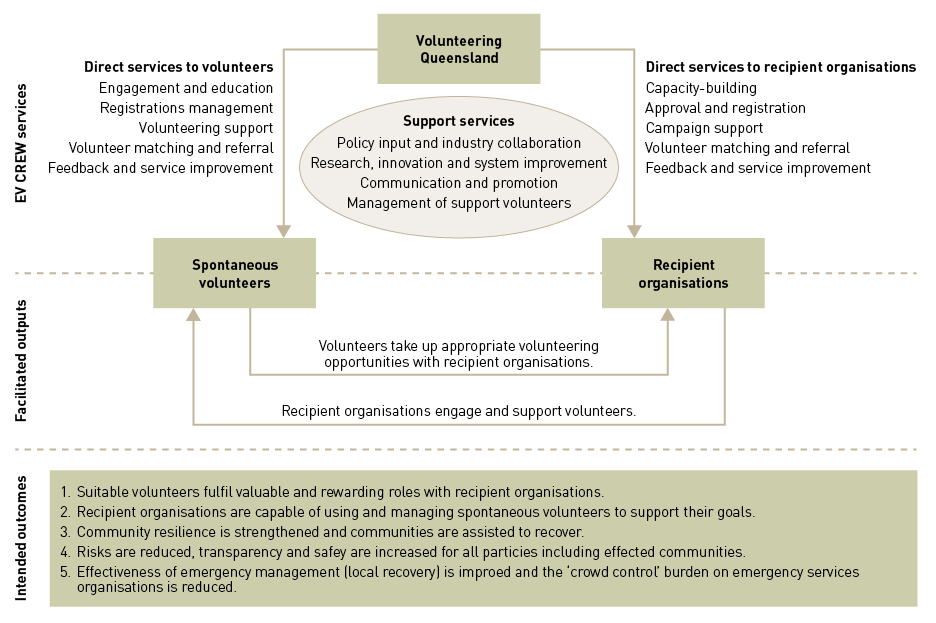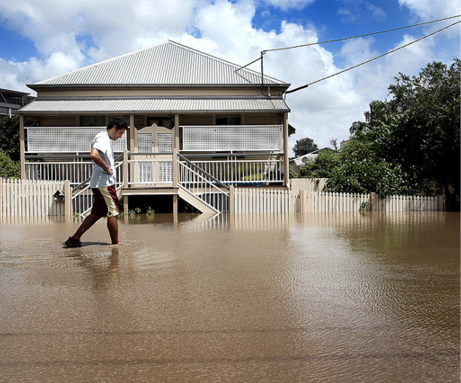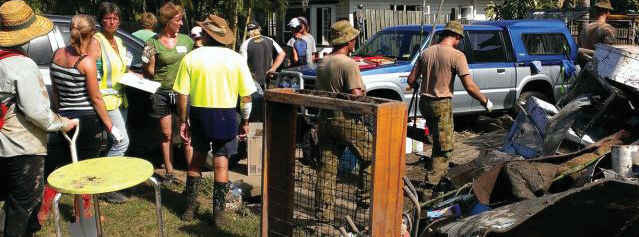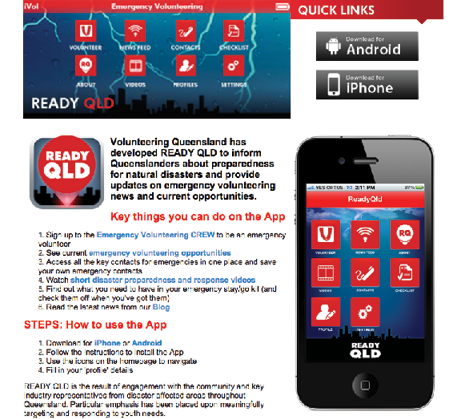
Spontaneous volunteers are:
‘those who seek to contribute on impulse—people who offer assistance following a disaster and who are not previously affiliated with recognised volunteer agencies and may or may not have relevant training, skills or experience’
(Cottrell 2010, p. 3, Australian Red Cross 2010).
Spontaneous volunteers may be associated with a formal organisation or they may be involved in informal and emergent volunteerism where people work together towards shared goals (Drabek & McEntire 2003) but in less formal ways that ‘typically lack formal elements of organisation’ (Whittaker, McLennan & Handmer 2015). They tend to be motivated by an immediate desire to help (Cottrell 2010), and to engage in shorter, fixed-term activities. They may or may not be involved in volunteering in an ongoing way outside the immediate emergency context or with organisations (Barraket et al. 2013).
Notably, until recently, government authorities have tended to overlook spontaneous volunteering when planning, and to regard them as an unpredictable and uncontrollable nuisance and risk rather than as a legitimate part of response and recovery (Helsloot & Ruitenberg 2004, Scanlon, Helsloot & Groenendaal 2014). Yet research shows that spontaneous volunteers contribute significantly to a range of important activities in the immediate aftermath of a disaster, including search and rescue, first aid, and the assessment of community needs (Whittaker, McLennan & Handmer 2015). As the International Federation of Red Cross and Red Crescent Societies have emphasised, ‘the success of relief efforts by those spontaneously offering their help depends on the capacity of agencies and authorities to integrate them quickly and effectively into a coordinated strategy’ (IFRC 2001, p. 146).
Spontaneous volunteers also significantly challenge more traditional models of volunteer management. These models were designed for a traditional style of volunteering that involves ‘a lifelong and demanding commitment’ to an organisation, and is underpinned by ‘traditional’ altruistic values and devotion to community service (Hustinx & Lammertyn 2003, p. 168). This is the style of volunteering that emergency services organisations have typically sought to develop in the past.
While people have always converged on disaster sites to help response and recovery activities (and also inadvertently complicate recovery operations) (Whittaker, McLennan & Handmer 2015, Fritz & Matthewson 1957, Kendra & Wachtendorf 2003), spontaneous volunteers are, in many respects, a non-traditional form of emergency volunteering. Compared to traditional volunteering styles, non-traditional forms of volunteering are, in general terms, more diverse, individualised, technology-enabled, autonomous, short-term, and less-formally structured (McLennan, Whittaker & Handmer 2015, Hustinx & Lammertyn 2003). Non-traditional forms of volunteering are on the rise, largely driven by changes in the nature of paid work, lifestyles and values in the 21st Century, as well as the revolution in new technology, among other things.
EV CREW is a best-practice example of a non-traditional management model developed for a non-traditional form of volunteering in a disaster context. This paper outlines the EV CREW model with a particular focus on intended outcomes for community resilience and emergency management. This case study is timely. Interest is increasing within Australian emergency management in spontaneous volunteering and a Spontaneous Volunteer Strategy was recently endorsed by the Australia-New Zealand Emergency Management Committee (ANZEMC 2015). Significantly, the EV CREW model operationalises many of the proposed objectives, principles and actions outlined in the Spontaneous Volunteer Strategy.
The case study presented here is small in size and based on three main sources of:
The EV CREW model is explained as well as the intentions and experiences of those who developed it. The case study does not evaluate the strengths and weaknesses of the model, but documents it to share some of the learning and experiences of those closely involved with it. Additional interviews are planned that will examine outcomes of EV CREW from the perspectives of its external stakeholders.
EV CREW was developed during a time of transition for Volunteering Queensland in late 2007 and early 2008. At this time, the organisation shifted away from a focus on supporting more traditional community-sector volunteering towards a wider view of generating better ways for people to tap into diverse and non-traditional forms of volunteering.
As a part of this shift, Volunteering Queensland engaged with the emergency management sector in Queensland, particularly through the State Community Recovery Committee (now the Human and Social Recovery Group) to explore how it could add value in that area. At this time a change of CEO brought in experience in disaster recovery from Australian Red Cross. He recognised a loss of social capital following Cyclone Larry in 2006 when large numbers of offers of assistance from the public were turned away by established emergency services organisations. This experience and collaboration with the State Community Recovery Committee created a new direction for Volunteering Queensland. It took on a formal role within the Queensland disaster management arrangements1 as the lead organisation for managing offers of assistance from the public. The development of EV CREW was a significant part in realising this role.
EV CREW is adapted from the business model of a recruitment agency. It involves Volunteering Queensland registering offers to volunteer from the public and live-matching registered people to specific requests for volunteers from organisations that support communities during and after disaster. Within this simple model, Volunteering Queensland has active roles as facilitator and broker as well as coordinator (see Figure 1).
Core EV CREW services are provided directly to potential and referred volunteers on one side, and recipient organisations on the other. Volunteering Queensland also provides a range of supportive services. The core services are provided by paid Volunteering Queensland staff and by a large pool of support volunteers who are trained to operate and support EV CREW. Almost 800 support volunteers have been trained to date.
Volunteering Queensland engages and educates people who are registered for, or interested in, volunteering both during and outside of volunteer campaign times (i.e. when volunteers are being actively matched to opportunities). Registrations of interest in emergency volunteering are taken over the phone, online through the Emergency Volunteering portal (www.emergencyvolunteering.com.au), and via the ReadyQld smartphone application (www.emergencyvolunteering.com.au/home/disaster-ready/menu/emergency-smartphone-app). Volunteering Queensland accepts both individual and group registrations and the service takes registrations at any time. Once registered, people are supported to participate in emergency volunteering with information on emergency management processes, specific volunteering opportunities and conditions, and volunteer rights and responsibilities.
Volunteer matching and referral is an active and labour-intensive process undertaken by staff and large numbers of trained volunteers assisting Volunteering Queensland. The matching and referral process is initiated by a request from a registered organisation. EV CREW operators first identify potential volunteers registered in its database who are appropriately skilled, located and available for a specific role. Volunteers are contacted via phone and email to let them know about the volunteering opportunity, secure their interest, and refer them to the recipient organisation. Once volunteers have concluded their volunteering role, they are asked for formal feedback about their experiences. This informs improvements to the system and the support offered to recipient organisations.
Volunteering Queensland provides important capacity-building support, for example through one-on-one, over-the-phone advice and assistance with all aspects of managing spontaneous volunteers, as well as with developing and undertaking volunteering opportunities. It approves and registers organisations to receive volunteers, provides support during their volunteering campaigns, and actively seeks out, recruits and refers volunteers to them. Registered organisations must satisfy Volunteering Queensland that they have appropriate volunteer support in place, for example, induction and insurance, as well as having well-designed and rewarding volunteering opportunities available that are sensitive to local needs and conditions.
Important exclusions to EV CREW’s core services are volunteer insurance, workplace health and safety, and volunteer induction, which are provided to volunteers by the recipient organisation. Also monitoring and compliance of recipient organisations, is beyond the capacity of a small non-profit organisation.
There are two main outputs of the EV CREW model, shown in Figure 1. Volunteers take up appropriate volunteering opportunities with recipient organisations and recipient organisations engage and support spontaneous volunteers to assist communities during and after an emergency event or disaster.

To this end, EV CREW has been activated for the following major events in Queensland:
Of these, the 2010-2011 Queensland floods, in particular the floods in Brisbane, was a standout event for EV CREW in terms of scale as well as the testing and refinement of the model and processes used. Overall, EV CREW managed approximately 120 000 registrations in response to this event. Of these, 86 000 were unique registrations from Queensland. It is worth noting that people’s enthusiasm to offer help led many to register multiple times, with registrations received from all states and territories of Australia as well as almost every country in the world. A conservative estimate of volunteers referred to organisations to assist with post-flood clean up, primarily the Brisbane City Council, is around 23 000. These referred EV CREW volunteers formed a part of the massive volunteer post-flood clean-up effort that came to be known in the media as the ‘Brisbane Mud Army’. Notably, the Mud Army also consisted of significant numbers of people informally helping family, friends and neighbours, as well as people who answered a call from the Brisbane Mayor to turn up to four coordination centres on two dedicated weekends to assist with the clean-up (Rafter 2013). Brisbane City Council estimates that over 50 000 people volunteered on the first of these weekends alone (Rafter 2013).
As at 30 June 2015, there were almost 82 000 individuals and groups registered with EV CREW as potential volunteers. This is a live database and the numbers change daily. All of these people are contacted to update their registration at least twice a year to ensure their interest in volunteering is current.
Also at this time, there were 72 organisations registered to receive volunteers (Table 1). They have provided over 128 discrete volunteering opportunities and received more than 32 000 volunteers through EV CREW (bearing in mind that a large majority were referred for Brisbane flood clean-up in 2011). Over half of the registered organisations are not-for-profit organisations, such as Australian Red Cross, Habitat for Humanity and Conservation Volunteers Australia. Smaller community groups registered with EV CREW include sporting clubs, community and relief centres, and neighbourhood houses.
Table 1: EV CREW volunteer opportunities and estimated referrals by type of recipient organisation, as at 30 June 2015.
| Group | Number registered | Volunteer opportunities offered | Volunteers referred |
|---|---|---|---|
Community groups* |
15 |
13 |
146 |
Emergency management agencies |
2 |
4 |
23 |
State government |
4 |
2 |
115 |
|
Local government (Brisbane City Council) |
9 |
30 |
28 212** (25 000) |
Non-profit organisations |
41 |
78 |
3967 |
Schools |
1 |
1 |
80 |
TOTAL |
72 |
128 |
32 543 |
(Source: Volunteering Queensland)
*This category includes a number of small, family-run businesses that received volunteers in 2011 only.
**This figure includes estimated numbers of volunteers referred to Brisbane City Council and other organisations in response to the 2010-2011 Queensland floods.

A resident walks through flood waters in the suburbs of Brisbane in 2011.
More broadly, there are five intended outcomes of the EV CREW model reported by internal stakeholders and Volunteering Queensland (see Figure 1).

The clean-up at Bundaberg with help from the ‘Mud Army’ following Cyclone Oswald.
Challenges and risks faced by Volunteering Queensland in delivering EV CREW services, as reported by stakeholders, were in four areas:
Volunteering Queensland’s capacity to engage with volunteers has increased considerably since it adopted a cloud-based client relationship management software system in 2011. This system has greatly improved Volunteering Queensland’s capacity to manage and monitor its registrations, communicate with large numbers of potential volunteers, and manage volunteer matching.
A significant challenge was people’s lack of knowledge about emergencies and emergency management processes. In response, Volunteering Queensland developed a number of communication tools to help educate people.2 Another challenge was managing the passionate but sometimes inappropriate offers of assistance, and the psychosocial needs of traumatised callers. Call scripts have been developed to support staff and volunteers to manage this but more work is needed in this area.
Managing the expectations of recipient organisations of their roles and those of Volunteering Queensland is a challenge, as is dealing with the varied volunteer management capacity and experience of organisations. A final important challenge is encouraging organisations that are more used to traditional volunteer management to rethink the role of volunteers in their organisation, and the potential contribution of spontaneous volunteers.
Challenges were faced in integrating EV CREW, and the central coordination of spontaneous volunteers more broadly, with the existing emergency management system. While collaboration with the State Human and Social Recovery Group as well as the Local Government Association of Queensland has advanced this integration, challenges remain. These relate to the culture change required within the established emergency management system to support more non-traditional volunteering (e.g. from a command-and-control culture to a more cooperative, resilience-based one), and better delineation of roles and working relationships.
Risks identified with the EV CREW model stem from the actions of recipient organisations that are unfamiliar with spontaneous volunteering. They included the risk of poorly-managed or ill-conceived volunteering opportunities turning people away from volunteering, small community-based organisations becoming over-burdened or overwhelmed during an emergency event, and volunteering opportunities running counter to either formal emergency management processes or local community needs. Notably all of these risks are reduced through the services offered by Volunteering Queensland. Volunteering Queensland itself lacks funding for EV CREW services and there is a lack of clarity around its liability as the coordinating organisation.
Experience with implementing the EV CREW model raises important questions—as well as provides some answers—about the appropriate place for spontaneous volunteers within Australian emergency management, and about the role of not-for-profit organisations in this area (Fitzpatrick, Molloy & Haigh 2014). Non-traditional forms of volunteering present challenges for existing emergency management processes (e.g. Sauer et al. 2014, Fernandez, Barbera & van Dorp 2006). However, when system changes are made that integrate them appropriately, they have potential to improve the effectiveness of emergency response and recovery and strengthen community resilience. EV CREW is an important Australian model for doing this and it has been used in multiple situations. Appropriate coordination of this form of volunteering can lead to more rewarding volunteer experiences and reduce a range of risks for those involved. Importantly, the EV CREW model acknowledges that spontaneous volunteering is a legitimate component of disaster recovery and resilience activities. A similar view is seen in sociological research on citizen responses to disasters, which shows that spontaneous and emergent volunteering is inevitable, normal, and brings benefits to disaster recovery such as increased surge capacity, awareness of local needs, innovation, adaptability, and speed (Fernandez, Barbera & van Dorp 2006).
The role Volunteering Queensland has filled in developing and managing EV CREW suggests that not-for-profit organisations, particularly volunteering peak bodies, have a significant part to play in Australian emergency management. Indeed, their role is already expanding. With strong support from Volunteering Queensland, other volunteering peak bodies are in various stages of adapting the EV CREW model for use in other Australian jurisdictions, most notably in the ACT, Tasmania and Victoria. This shows an expanding role for these organisations as brokering agents between the more formal, structured response to emergencies by established emergency management organisations, and the more informal, emergent response by the public (Fitzpatrick, Molloy & Haigh 2014). This case study shows how not-for-profit organisations value-add to the emergency management process by bringing new perspectives, expertise and experiences.

This EV CREW case study shows that central coordination of spontaneous volunteers does not replace traditional emergency management volunteering or less formal helping behaviour and emergent volunteerism. Instead, EV CREW was designed to increase the variety of ways available to people to contribute, particularly during response and recovery, in addition to those that already exist. To this end, there are two strong messages relayed by Volunteering Queensland to people when they are considering registration with EV CREW. These are:
The EV CREW model is one way to extend and adapt existing emergency management arrangements to become more inclusive and integrated with the less formal components of a community’s recovery processes (Scanlon et al. 2014). It reflects elements of the shift taking place in risk management away from top-down, command-and-control approaches towards more people-oriented approaches ‘where the public is a central element and resource in disaster risk management’ (Scolobig et al. 2015, p. 205). In broad terms, this shift is reasonably well-supported in Australia with widespread support for building community resilience and sharing responsibility (COAG 2011, Duckworth 2015, McLennan & Handmer 2013). While the recent Spontaneous Volunteer Strategy represents an important step towards advancing these ideas in volunteer management at a national policy level, EV CREW presents an important best-practice model for how these ideas can be operationalised on-the-ground.
Australia-New Zealand Emergency Management Committee (ANZEMC) 2015, Spontaneous Volunteer Strategy: Coordination of volunteer effort in the immediate post disaster stage. Canberra: Australia-New Zealand Emergency Management Committee (Community Engagement Sub-Committee).
Australian Red Cross 2010, Spontaneous Volunteer Management Resource Kit: Helping to manage spontaneous volunteers in emergencies. Canberra: Commonwealth of Australia, Australian Red Cross.
Barraket J, Keast R, Newton CJ, Walters K & James E 2013, Spontaneous volunteering during natural disasters. Brisbane: Queensland University of Technology.
COAG 2011, National Strategy for Disaster Resilience: building our nation’s resilience to disasters. Canberra, ACT: Council of Australian Governments.
Cottrell A 2010, Research report: A survey of spontaneous volunteers. Carlton, Victoria: Australian Red Cross.
Drabek TE & McEntire DA 2003, Emergent phenomena and the sociology of disaster: lessons, trends and opportunities from the research literature. Disaster Prevention and Management, 12, pp. 97-112.
Duckworth M 2015, The idea of resilience and shared responsibility in Australia. In Bach, R. (ed.) Strategies for Supporting Community Resilience: Multinational Experiences. Stockholm: CRISMART & The Swedish Defence University, pp. 83-118.
Fernandez L, Barbera J & van Dorp J 2006, Spontaneous volunteer response to disasters: The benefits and consequences of good intentions. Journal of Emergency Management, 4, pp. 57-68.
Fitzpatrick T, Molloy J & Haigh R 2014, The role of NGOs in building sustainable community resilience. International Journal of Disaster Resilience in the Built Environment, 5.
Fritz CE & Matthewson J 1957, Convergence Behaviour in Disasters. Washington, DC: National Academy of Sciences, National Research Council.
Helsloot I & Ruitenberg A 2004, Citizen Response to Disasters: a Survey of Literature and Some Practical Implications. Journal of Contingencies and Crisis Management, 12, pp. 98-111.
Hustinx L & Lammertyn F 2003, Collective and reflexive styles of volunteering: a sociological modernization perspective. Voluntas: International Journal of Voluntary and Nonprofit Organizations, 14, pp. 167-187.
IFRC 2001, World disasters report: focus on recovery. Geneva: International Federation of Red Cross and Red Crescent Societies.
Kendra JM & Wachtendorf T 2003, Reconsidering convergence and converger legitimacy in response to the World Trade Center Disaster. In: Clarke L. (ed.) Terrorism and Disaster: New Threats, New Ideas (Research in Social Problems and Public Policy, vol 11). Emerald Group Publishing Ltd, pp. 97-122.
McLennan B, Whittaker J & Handmer J 2015, Emergency volunteering in Australia: transforming not declining. Australia: Bushfire and Natural Hazards CRC.
McLennan BJ & Handmer JH 2013, Sharing responsibility in Australian disaster management. Melbourne: RMIT University & Bushfire CRC.
Rafter F 2013, Volunteers as agents of co-production: ‘Mud armies’ in emergency services. In: Lindquist, E. A. (ed.) Putting Citizens First: Engagement in Policy and Service Delivery for the 21st Century. Canberra: ANU E Press.
Sauer LM, Catlett C, Tosatto R & Kirsch TD 2014, The utility of and risks associated with the use of spontaneous volunteers in disaster response: a survey. Disaster Medicine and Public Health Preparedness, 8, pp. 65-69.
Scanlon J, Helsloot I & Groenendaal J 2014, Putting it all together: Integrating ordinary people into emergency response. International Journal of Mass Emergencies and Disasters, 32, pp. 43-63.
Scolobig A, Prior T, Schröter D, Jörin J & Patt A 2015, Towards people-centred approaches for effective disaster risk management: Balancing rhetoric with reality. International Journal of Disaster Risk Reduction, 12, pp. 202-212.
Whittaker J, McLennan B & Handmer J 2015, A review of informal volunteerism in emergencies and disasters: Definition, opportunities and challenges. International Journal of Disaster Risk Reduction, 13, pp. 358-368.
Dr Blythe McLennan, Dr Joshua Whittaker and Professor John Handmer are researchers at RMIT University. They are examining the integration of non-traditional forms of emergency volunteering with the formal emergency managmenet system in a project with the Bushfire and Natural Hazards Cooperative Research Centre (see www.bnhcrc.com.au/research/resilient-people-infrastructure-and-institutions/248).
Julie Molloy is the Director of Social Engagement at Volunteering Queensland and a PhD Candidate at RMIT University.
1 Queensland disaster management arrangements. At: www.disaster.qld.gov.au/About_Disaster_Management/DM_arrangments.html.
2 See for example the Disaster Ready Communities program, www.emergencyvolunteering.com.au/component/tags/tag/67-disaster-ready-communities.